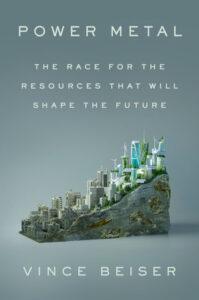Book Review: Power Metal
By Vince Beiser
 Power Metal sounds the alarm on the environmental and social consequences of electronic and digital energy—and how the ways we are combating climate change come at a cost.
Power Metal sounds the alarm on the environmental and social consequences of electronic and digital energy—and how the ways we are combating climate change come at a cost.
When we bring our mobile phone to life with a tap or settle in behind the wheel of our car, few of us give much thought to the raw materials required to make these sometimes miraculous- seeming devices work.
Journalist Vince Beiser has reflected deeply on that subject, and the result, Power Metal: The Race for the Resources That Will Shape Our Future, is a sharp cautionary tale about the dilemmas facing humanity as we advance deeper into what he calls the Electro-Digital Age, especially as we pursue the essential transition to an energy-renewable future.
Everything comes with a cost, Beiser reminds us, even when it comes to the use of so-called critical metals like lithium, cobalt and nickel. These resources are fundamental to the massive expansion of electric cars and the clean energy sources (namely solar and wind power) that are necessary to combat climate change.
What makes that truth problematic, he argues, is that the inevitable price of progress often falls most heavily on the residents of impoverished countries who bear the burden of first extracting these materials and later disposing of the batteries and printed circuit boards, for example, in which they’re used.
Beiser’s journey to this insight takes him from the streets of his hometown of Vancouver, British Columbia, where he tracks an “urban miner” digging through dumpsters for salvageable products like copper wiring, to a lithium mining operation in Chile’s Atacama desert, to a garbage dump in Lagos, Nigeria, where “e-waste scrappers” work in hazardous conditions to recycle electronic products.
Power Metal is a concise, but thoroughly researched, work crammed with eye-popping statistics—among them the fact that 75 pounds of ore must be mined to build one four-and-a-half ounce iPhone. It investigates highly touted technologies like sea mining, whose promised benefits may conceal massive environmental risks.
In the final section of his book, Beiser offers some prescriptions to reduce the planet’s insatiable demand for resources that go beyond costly and energy-intensive recycling, including broadening the scope of right to repair laws, making urban spaces more friendly to bicyclists and deeply questioning our infatuation with the automobile.
Whatever one thinks of the practicality of some of his proposals, Beiser has performed a vital service by alerting both policymakers and ordinary citizens to some of the critical choices facing us.



